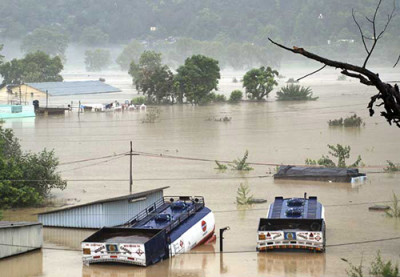India’s approach to adaptation: A good start but lacks a strong long-term focus

On 2nd October, India submitted its ‘intended nationally determined contribution’ (INDC) to the secretariat of the United Nations Framework Convention on Climate Change (UNFCCC), ahead of the 21st session of the Conference of Parties (COP21) to the UNFCCC, which begins in Paris on 30 November.
India’s INDC generated considerable international interest because of the fair and ambitious mitigation targets and focus on renewable energy. The INDC is, however, a comprehensive document that also presents adaptation initiatives, which are equally, if not more, important given India’s vulnerability to climate change. Whilst India has done well to present a balanced INDC by highlighting adaptation issues and governmental initiatives at the UNFCCC, the adaptation approach it is advocating has some shortcomings.
India recognises its vulnerability to climate impacts and attempts to attach the same importance to this issue as the need to mitigate. Adaptation is promoted as part of development, with a focus on vulnerability reduction and poverty alleviation; this demonstrates that their interconnectedness is recognised. However, the INDC does not attempt to distinguish between reducing the risk to existing climatic variability and measures which take into account changing risks in the future. Adaptation for development is a good starting point but should not encourage a ‘business as usual’ approach to risk reduction. Current activities have been outlined in a briefing paper that was prepared for COP20 in Lima, Peru, last year. The paper was based on the National Environmental Policy (2006) and the guidelines from the National Action Plan on Climate Change (2008) guidelines. However, these policies themselves have some shortcomings and may not effectively guide adaptation to future climate change.
Actions plans for each State (the sub-national administrative units in India) are supposed to delineate regional priorities for adaptation and help mainstream adaptation decision-making, although more clarity is needed about what this involves. Training of local stakeholders and participatory development of adaptation plans are also required. Conversely, some commentators have highlighted that most plans demonstrate a tendency to “skirt around measures that are economically or politically untenable, even if they achieve substantial climate gains”. Others have also pointed out that the ad hoc filtering of recommendations results in a “mix of broad statements of objective and specific actions” which provides “neither a clear vision nor a clear plan”. The planning framework lacks systematic formulation and so incremental changes are typically recommended, although it is widely acknowledged that some sectors and regions will need transformational adaptation, especially when faced with limits to adaptation.
Such limits to adaptation are very relevant when considering the changing climatic extremes to which India is particularly vulnerable. Therefore, disaster management has to focus on long-term planning issues and should not be restricted just to disaster mitigation and response. India’s INDC emphasises that “85% of India’s area is vulnerable to one or multiple hazard” and that India has suffered “annual average flood damage of INR47.45 billion” (£480 million). Unfortunately, disaster management focuses more on ‘holistic disaster risk reduction and response’ for reducing existing vulnerability than on changing risks due to climate change and human pressures. Extreme weather is expected to intensify in the future, and events like the Uttarakhand floods in 2013 may not be so uncommon. The floods exposed governance failure and human developmental pressure on a fragile ecosystem, and prompted a re-examination of how holistic the disaster reduction mechanisms actually are. Therefore, risk reduction will have to be mainstreamed into existing decision-making, together with effective implementation of development and infrastructural guidelines, to account for human pressures along with changes in extremes brought about by climate change.
Long-term decision-making will be facilitated by the better monitoring emphasised by the INDC, but decision-making processes themselves will have to carefully integrate stakeholder concerns in addressing key vulnerabilities, which are often multi-sectoral. For example, a change in the availability of water resources is not just a water supply issue, but is also intrinsically connected to agriculture, aquatic ecosystems, energy (generation and usage), droughts and floods, biodiversity and health, among others. The processes of the National Action Plan on Climate Change and the State action plans on climate change disregard these critical linkages, perhaps due to entrenched differences in the functioning and mandates of ministries, departments and implementation agencies at various levels. In fact, several state plans have similarly-structured chapters contributed by different departments, with their corresponding ‘wish lists’, but without demonstrating any active consideration of inter-departmental coordination and convergence. The INDC is based on such processes, so a project-oriented implementation of adaptation under each mission may be needed. This approach is also inherently inflexible and does not allow for adaptive management to be incorporated into regular decision-making processes. This may be a cause for concern if a project that is useful in the short term turns out to be maladaptive in the long term.
A broader engagement with all future developmental and infrastructural aspects is therefore required for adaptation to be effectively mainstreamed. Such mainstreaming will also help to engage the private sector in adaptation. At present the private sector’s involvement is primarily restricted to mitigation in India’s INDC, as well the overarching National Environmental Policy. Private sector involvement is especially relevant considering that the five-year total budget requirement of State action plans on climate change altogether is £114 billion, while this year’s budget for the National Adaptation Fund is about £35 million. Even with support from the developed world, which India seeks in Paris, financing adaptation will require greater engagement and effort.

